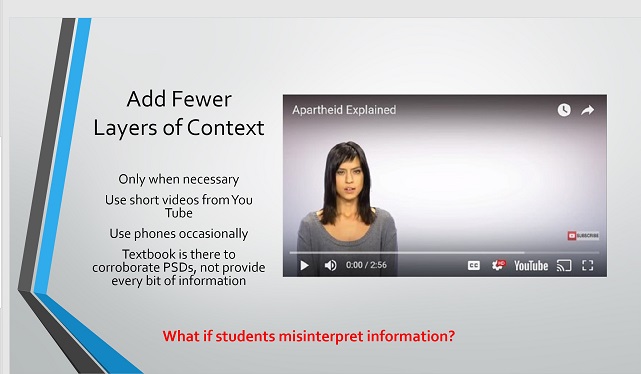
By Risa Gluskin
World History from 1450 (CHY4U) is very full. Very full of content. That’s a problem.
This semester, after reviewing my own past advice to teachers, I have decided to focus on one nugget: use fewer layers of context. My version of CHY4U is not a narrative of world history; it’s a skill- and primary source-based inquiry-style course. I know a lot more than my students about the topics, obviously. As the teacher it is incumbent on me to use that knowledge to structure bite-size lessons rather than deliver oodles of background information to my students. I’d like to avoid the pitfall of overload which would detract from students’ skill development.
Let me give an example of a recent topic revision in this vein. On the topic of Japan’s early interactions with Jesuit missionaries in the 1500s, I had always focused on having students interpret differing theories behind the rationale for Japanese exclusion of, first, Christian missionaries, then, almost all foreigners. This theorizing required a lot of context. After doing a little more reading this semester, and with the desire to simplify, I changed gears, moving away from the focus on theoretical interpretations toward a more straightforward application of cause-consequence.
Now that I don’t distribute a textbook, I don’t feel students need to know everything that happened. I can sum up only the most needed context for them. In the case of the Japanese interaction with foreigners, after a brief contextual Power Point, I gave students a worksheet I had created which randomly listed 18 causes and consequences. The students sorted them into 9 cause-consequence pairs. Superficially the exercise may have seemed simple; in reality the sorting required brain power, especially given the limited context.
Here’s an example of doing an activity with NO context. On the third day of class I threw together a quick new historical thinking concept (HTC) activity using images of five current events. I simply chose two photos related to each of the topics below and had each group identify which HTC they thought best fit it. To reinforce that there is not always one correct answer I had each group rotate through each photo and we compared choices at the end as a class. I may have had a particular HTC in mind when I chose the images but I was happily open to their choices if well justified. I should note that some students had the impulse to research the topics. Though I applauded their interest, I felt it was enough for me to summarize each topic in a sentence or two for them.
- Pipelines in Canada (perspectives)
- McArthur serial killings (cause-consequence)
- Venezuela crisis (perspectives)
- Invasions of Afghanistan (continuity and change)
- Removal of John A. Macdonald statues (perspectives)
If you’d like to see the actual images I chose please go to my blog and scroll down to Activity 1: Day 1 HTC.
When topics are simple the course can certainly feel bare bones, sort of like we’re jumping from one topic to another too quickly. However, there is connective tissue built into the course in the form of skill-building, HTCs, assessments as and for, as well as an overarching course question (“how did we get here?”) and successive unit questions.
The biggest difficulty in teaching with less context is how to decide which context to employ. Case in point, I’m currently in the midst of overseeing my student teacher’s planning of a one-day lesson on Las Casas and the impact of the Spanish in Mexico; I’m trying to help her choose just the right amount and type of context. At times it’s helpful that I’ve been teaching about Las Casas for over 15 years and I know so many of the intricacies surrounding his complex relationship with the Indigenous people. Other times, it’s an obstacle to know so much and only have one day to help the students see the significance of his position.
Never having been much for new year’s resolutions, I hope I can stick to my goal of limiting the layers of context. Having been a context freak in the past, I hope I — and my students — can learn to live with fewer servings! I’ll report back about on my progress toward my goal over the course of the semester.
Risa Gluskin is a history and student success teacher in Toronto. Visit her blog at gluskin.ca.


